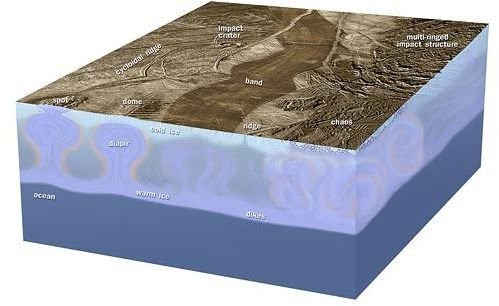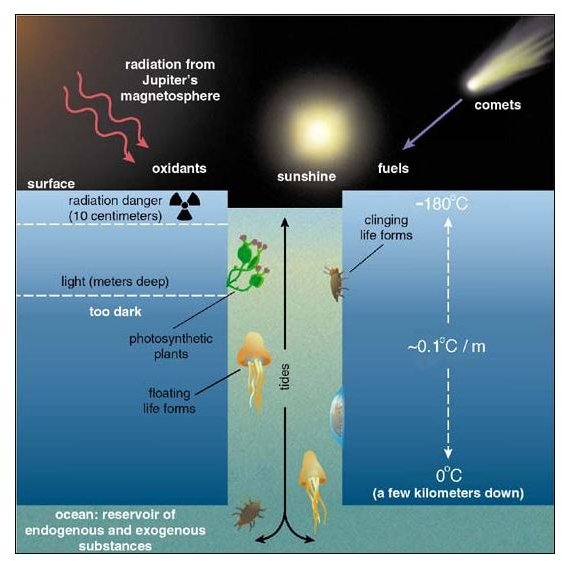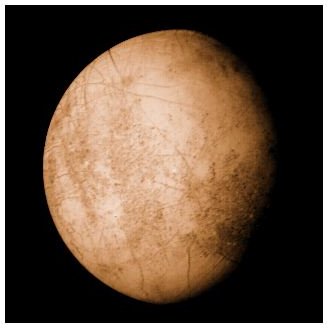Interesting facts about Jupiter's Icy Moon, Europa, including information about the possibility of an ocean under its surface.
Europa
The Facts
-
Year discovered: 1610
-
Discovered by: Galileo Galilei
-
Position among Jupiter’s moons: 6th satellite from the planet
-
Size among Galilean moons: Smallest
-
Average distance to Jupiter: 670,900 km, 416,877 miles
-
Rotation: synchronous with Jupiter (9hr 50m 30s)
-
Orbital period: 3days 13hr 13m 26.4s (3.551181 Earth days)
-
Orbital Inclination to Jupiter’s equator: 0.470 degrees
-
Eccentricity: 0.009
-
Diameter (equatorial): 3,138 km, 1,950 miles
-
Mass: 4.80×1022 kg, 10.5821x1022 lbs
-
Mean Density: 3,010 kg/m3, 187.908 lbs/ft3
-
Gravity: 0.134g
-
Escape Velocity: 2.025 km/s, 1.258 miles/s
-
Surface temperature (average): -171C, -276F, 102K
-
Surface pressure: 1 μPa, 10-11 bars, 9.8x10-12 atm
-
Atmospheric composition: Almost entirely molecular oxygen (O2)
-
Albedo: 0.67 +/- 0.03
What is really cool

-
An ocean trapped under ice. Europa is covered by a water sheet estimated to be a hundred kilometers (62 miles) thick, the surface layer being frozen ice, the rest probably in liquid form.
-
Smooth as baby skin. Europa’s most prominent surface features, its lineae (lines), are a result of brightness contrast in images, between adjacent surface areas. There are no large mountains or deep ridges, and only small craters since the surface of Europa is relatively new: Between 20 and 200 million years old.
-
Lots of oxygen, but no air to breathe. Europa’s atmosphere practically consists of nothing but oxygen. This means two things: it’s not breathable by human standards since Earth’s atmosphere is mainly nitrogen and only 22% oxygen, and it’s extremely thin. The oxygen is continuously produced from the ice surface, by way of radiolysis (radiation splits the water molecules into hydrogen and oxygen), but most of it escapes into space.
-
A possible harbor of life. If the hypothesis of the largest part of the water sheet being in liquid form is confirmed, then the volume of water will be twice as much as Earth’s oceans, and there could exist microbial life, in conditions similar to certain deep ocean areas where energy from hydrothermal vents provides organisms with energy, instead of the sun. As far we know, this is the most realistic probability for life in our solar system. A must read on the subject is Richard Greenberg’s, Unmasking Europa - The Search For Life On Jupiter’s Ocean Moon.

Credits
https://en.wikipedia.org/wiki/Europa_(moon)
Unmasking Europa - The Search For Life On Jupiter’s Ocean Moon, by Richard Greenberg (ISBN 978-0387479361)
This post is part of the series: Jupiter’s Moon, Europa, One of the Galilean Moons
Read the facts about the fourth largest Galilean moon of Jupiter, Europa. Mythological, physical, orbital and theoretical facts about Europa are available in this series.
